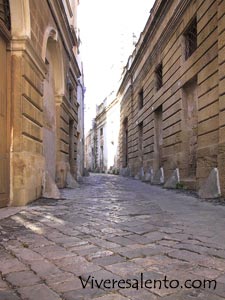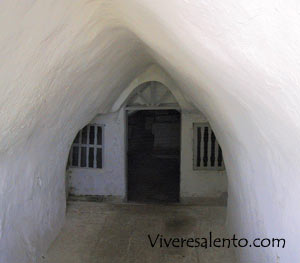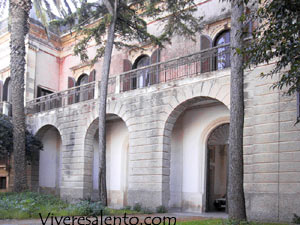|
|

| Inhabitants'
name: Galatinesi |
On the civic coat of arms of Galatina there are two crossed
keys (pontifical keys), a baronial crown and an
 owl.
The legend says that the village was founded by some Greek settlers, dedicated
to the Goddess Minerva and named after her ‘Kali Athina’. This is what the
legend says but actually the first historical documents date to the feudal time.
The first historical document dates to the 1178 but we are quite certain that
the village was attacked by the Turks in the 9th century, previously also by the
Goths and by the Normans in the 11th century. The first feudatory of Galatina
was Glisio De Matino (Swabian period). In 1269 he left the village to Anselmo De
Toucy who died in 1273 and left Galatina to his brother Philippe who died in
1277. The village was taken by Narjaud, who died in 1299, and then by his
brother Eaudes who left it to his son Filippotto but he gave it to Ugo Del Balzo
for a Calabrian feud. In 1331 the feud was taken by his son, Raimondo Del Balzo.
In 1376 his place was taken by a nephew, Nicola Orsini, and in 1381 the village
was ruled by Raimondello Orsini Del Balzo who built the church of St Catherine
of Alexandra in 1391, which nowadays is a National monument. Raimondello married
Maria D’Enghien and his son Gian Antonio was the last heir of the family and
took his place in the 15th century. In 1479 Lodovico Campofregoso ruled the
village and in 1485 Giovanni Castriota Scanderbeg who died in 1506. His son
Ferrante ruled until 1561. At this time came the Sanseverinos and the Spinolas.
The owl.
The legend says that the village was founded by some Greek settlers, dedicated
to the Goddess Minerva and named after her ‘Kali Athina’. This is what the
legend says but actually the first historical documents date to the feudal time.
The first historical document dates to the 1178 but we are quite certain that
the village was attacked by the Turks in the 9th century, previously also by the
Goths and by the Normans in the 11th century. The first feudatory of Galatina
was Glisio De Matino (Swabian period). In 1269 he left the village to Anselmo De
Toucy who died in 1273 and left Galatina to his brother Philippe who died in
1277. The village was taken by Narjaud, who died in 1299, and then by his
brother Eaudes who left it to his son Filippotto but he gave it to Ugo Del Balzo
for a Calabrian feud. In 1331 the feud was taken by his son, Raimondo Del Balzo.
In 1376 his place was taken by a nephew, Nicola Orsini, and in 1381 the village
was ruled by Raimondello Orsini Del Balzo who built the church of St Catherine
of Alexandra in 1391, which nowadays is a National monument. Raimondello married
Maria D’Enghien and his son Gian Antonio was the last heir of the family and
took his place in the 15th century. In 1479 Lodovico Campofregoso ruled the
village and in 1485 Giovanni Castriota Scanderbeg who died in 1506. His son
Ferrante ruled until 1561. At this time came the Sanseverinos and the Spinolas.
The Gallarati Scottis were the last family to rule the village because in 1806 the
feudal system came to end. Among the famous people of Galatina we can remember:
Gioachino Toma, Giuseppe Lillo and Pasquale Caffaro. Gioachino Toma was born in
1836 and was one of the greatest painters of the 19th century. His father died
when he was 6 and his mother decided him to study in a monastery. He had a bent
for drawing and painting and his teachers recognised it. When also his mother
died, he lived with his grandmother for a while then moved to Naples where he
worked to the decoration of the house of Francesco II. He taught in the School
of Fine Arts in Naples but he never gave up painting. As other wonderful artists
he lived in poverty and his works have been much better appreciated after 1891
when he died. Nowadays some of his paintings can be visited in the Gallery of
Modern Art in Rome. Giuseppe Lillo was born in 1814 and was a great composer and
pianist. He played in
Gallarati Scottis were the last family to rule the village because in 1806 the
feudal system came to end. Among the famous people of Galatina we can remember:
Gioachino Toma, Giuseppe Lillo and Pasquale Caffaro. Gioachino Toma was born in
1836 and was one of the greatest painters of the 19th century. His father died
when he was 6 and his mother decided him to study in a monastery. He had a bent
for drawing and painting and his teachers recognised it. When also his mother
died, he lived with his grandmother for a while then moved to Naples where he
worked to the decoration of the house of Francesco II. He taught in the School
of Fine Arts in Naples but he never gave up painting. As other wonderful artists
he lived in poverty and his works have been much better appreciated after 1891
when he died. Nowadays some of his paintings can be visited in the Gallery of
Modern Art in Rome. Giuseppe Lillo was born in 1814 and was a great composer and
pianist. He played in
 the
Philharmonic Society Bellini of Palermo and in the Royal Academy of Naples. He
was taken as a prisoner near Naples where he died in 1863. Pasquale Caffaro was
born in 1708 in a wealthy family. His natural bent for music was found out by
the Marquis of Odierna who let him enter the Conservatory of the Pity in Naples.
One of his teachers, Leonardo Leo, saw at once his gift for music and followed
him for a long time. He studied for 12 years and this made him the greatest
harmonist of his period. When Leonardo Leo died in 1744, Pasquale took his place
and started to compose in 1745. In 1771 he became Maestro of the Palatine Chapel
of Naples and afterwards he went to teach singing to the court of Queen Mary
Caroline of Austria. He was a well-known artist in all Europe. He died in Naples
in 1787 of gangrene and his corpse was laid in the Chapel of St Cecil next to
his teacher Leonardo Leo. the
Philharmonic Society Bellini of Palermo and in the Royal Academy of Naples. He
was taken as a prisoner near Naples where he died in 1863. Pasquale Caffaro was
born in 1708 in a wealthy family. His natural bent for music was found out by
the Marquis of Odierna who let him enter the Conservatory of the Pity in Naples.
One of his teachers, Leonardo Leo, saw at once his gift for music and followed
him for a long time. He studied for 12 years and this made him the greatest
harmonist of his period. When Leonardo Leo died in 1744, Pasquale took his place
and started to compose in 1745. In 1771 he became Maestro of the Palatine Chapel
of Naples and afterwards he went to teach singing to the court of Queen Mary
Caroline of Austria. He was a well-known artist in all Europe. He died in Naples
in 1787 of gangrene and his corpse was laid in the Chapel of St Cecil next to
his teacher Leonardo Leo.
|